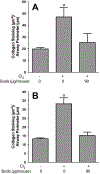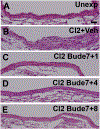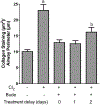Inhibition of chlorine-induced airway fibrosis by budesonide
- PMID: 30189237
- PMCID: PMC6342561
- DOI: 10.1016/j.taap.2018.08.024
Inhibition of chlorine-induced airway fibrosis by budesonide
Abstract
Chlorine is a chemical threat agent that can be harmful to humans. Acute inhalation of high levels of chlorine results in the death of airway epithelial cells and can lead to persistent adverse effects on respiratory health, including airway remodeling and hyperreactivity. We previously developed a mouse chlorine exposure model in which animals developed inflammation and fibrosis in large airways. In the present study, examination by laser capture microdissection of developing fibroproliferative lesions in FVB/NJ mice exposed to 240 ppm-h chlorine revealed upregulation of genes related to macrophage function. Treatment of chlorine-exposed mice with the corticosteroid drug budesonide daily for 7 days (30-90 μg/mouse i.m.) starting 1 h after exposure prevented the influx of M2 macrophages and the development of airway fibrosis and hyperreactivity. In chlorine-exposed, budesonide-treated mice 7 days after exposure, large airways lacking fibrosis contained extensive denuded areas indicative of a poorly repaired epithelium. Damaged or poorly repaired epithelium has been considered a trigger for fibrogenesis, but the results of this study suggest that inflammation is the ultimate driver of fibrosis in our model. Examination at later times following 7-day budesonide treatment showed continued absence of fibrosis after cessation of treatment and regrowth of a poorly differentiated airway epithelium by 14 days after exposure. Delay in the start of budesonide treatment for up to 2 days still resulted in inhibition of airway fibrosis. Our results show the therapeutic potential of budesonide as a countermeasure for inhibiting persistent effects of chlorine inhalation and shed light on mechanisms underlying the initial development of fibrosis following airway injury.
Keywords: Airway fibrosis; Chemical threat agent; Chlorine; Corticosteroid; Inflammation.
Copyright © 2018 Elsevier Inc. All rights reserved.
Figures











Similar articles
-
Abnormal epithelial structure and chronic lung inflammation after repair of chlorine-induced airway injury.Am J Physiol Lung Cell Mol Physiol. 2015 Jan 15;308(2):L168-78. doi: 10.1152/ajplung.00226.2014. Epub 2014 Nov 14. Am J Physiol Lung Cell Mol Physiol. 2015. PMID: 25398987 Free PMC article.
-
Early treatment of chlorine-induced airway hyperresponsiveness and inflammation with corticosteroids.Toxicol Appl Pharmacol. 2013 Sep 1;271(2):168-74. doi: 10.1016/j.taap.2013.04.037. Epub 2013 May 22. Toxicol Appl Pharmacol. 2013. PMID: 23707766
-
Differential susceptibility of inbred mouse strains to chlorine-induced airway fibrosis.Am J Physiol Lung Cell Mol Physiol. 2013 Jan 15;304(2):L92-102. doi: 10.1152/ajplung.00272.2012. Epub 2012 Nov 21. Am J Physiol Lung Cell Mol Physiol. 2013. PMID: 23171502 Free PMC article.
-
Persistent effects of chlorine inhalation on respiratory health.Ann N Y Acad Sci. 2016 Aug;1378(1):33-40. doi: 10.1111/nyas.13139. Epub 2016 Jul 6. Ann N Y Acad Sci. 2016. PMID: 27385061 Free PMC article. Review.
-
Do corticosteroids have a role in preventing or reducing acute toxic lung injury caused by inhalation of chemical agents?Clin Toxicol (Phila). 2011 Feb;49(2):61-71. doi: 10.3109/15563650.2011.553196. Clin Toxicol (Phila). 2011. PMID: 21370942 Review.
Cited by
-
Bioinformatics analysis and verification of gene targets for benign tracheal stenosis.Mol Genet Genomic Med. 2020 Jun;8(6):e1245. doi: 10.1002/mgg3.1245. Epub 2020 Apr 20. Mol Genet Genomic Med. 2020. PMID: 32309912 Free PMC article.
-
Differential modulation of lung aquaporins among other pathophysiological markers in acute (Cl2 gas) and chronic (carbon nanoparticles, cigarette smoke) respiratory toxicity mouse models.Front Physiol. 2022 Sep 28;13:880815. doi: 10.3389/fphys.2022.880815. eCollection 2022. Front Physiol. 2022. PMID: 36246134 Free PMC article.
-
Lung injury and oxidative stress induced by inhaled chlorine in mice is associated with proinflammatory activation of macrophages and altered bioenergetics.Toxicol Appl Pharmacol. 2023 Feb 15;461:116388. doi: 10.1016/j.taap.2023.116388. Epub 2023 Jan 20. Toxicol Appl Pharmacol. 2023. PMID: 36690086 Free PMC article.
-
IL-1β augments TGF-β inducing epithelial-mesenchymal transition of epithelial cells and associates with poor pulmonary function improvement in neutrophilic asthmatics.Respir Res. 2021 Aug 3;22(1):216. doi: 10.1186/s12931-021-01808-7. Respir Res. 2021. PMID: 34344357 Free PMC article.
-
Epigenetic Reprogramming of Tumor-Associated Fibroblasts in Lung Cancer: Therapeutic Opportunities.Cancers (Basel). 2021 Jul 27;13(15):3782. doi: 10.3390/cancers13153782. Cancers (Basel). 2021. PMID: 34359678 Free PMC article. Review.
References
-
- Andres SA, Wittliff JL, 2011. Relationships of ESR1 and XBP1 expression in human breast carcinoma and stromal cells isolated by laser capture microdissection compared to intact breast cancer tissue. Endocrine 40, 212–221. - PubMed
-
- Balakrishna S, Song W, Achanta S, Doran SF, Liu B, Kaelberer MM, Yu Z, Sui A, Cheung M, Leishman E, Eidam HS, Ye G, Willette RN, Thorneloe KS, Bradshaw HB, Matalon S, Jordt SE, 2014. TRPV4 inhibition counteracts edema and inflammation and improves pulmonary function and oxygen saturation in chemically induced acute lung injury. Am J Physiol Lung Cell Mol Physiol 307, L158–172. - PMC - PubMed
-
- Bassler D, Plavka R, Shinwell ES, Hallman M, Jarreau PH, Carnielli V, Van den Anker JN, Meisner C, Engel C, Schwab M, Halliday HL, Poets CF, Group NT, 2015. Early Inhaled Budesonide for the Prevention of Bronchopulmonary Dysplasia. N Engl J Med 373, 1497–1506. - PubMed
Publication types
MeSH terms
Substances
Grants and funding
LinkOut - more resources
Full Text Sources
Other Literature Sources
Medical
Molecular Biology Databases

